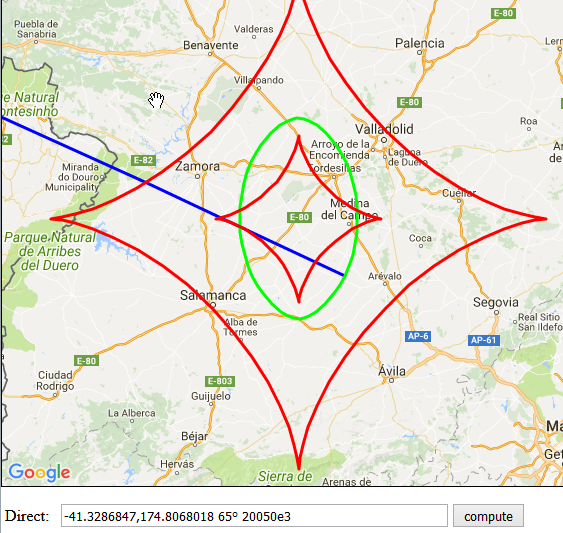It looks like you've figured things out OK. In case it helps, I give here the MATLAB/Octave code that I used to generate this Wikipedia figure showing the envelope:

The envelope is formed by the light blue lines which are geodesics emanating from a single point on the other side of the ellipsoid (the flattening of the ellipsoid is 1/10). If this were a sphere, all the geodesics would go through the antipodal point and the envelope would collapse to a point. The green curves are geodesic circles and the red curve is the cut locus which is a portion of the circle of latitude through the antipodal point.
This just shows the first envelope obtained by letting the geodesic go slightly more than 1/2 way round the ellipsoid. Bigger envelopes are generated if the geodesics go slight more than 1 time around (envelope is then centered on the originating point), or 1-1/2 times around (centered on the antipodal point), etc.
This code presumes that you have installed MATLAB Central packge 50605. I'm sorry that it's not very pretty; it was just intended to "get the job done".
function geod_envelope
thick=1;
thin=0.3;
red=[179,27,27]/255;
white=[1,1,1];
black=[0,0,0];
blue=[0,19,56]/100;
green=[9,45,27]/100;
xsize=4*0.66;ysize=4*0.66;
name='geod-envelope';
figure(1);
a = 1;
r = 10;
ell = [a, flat2ecc(1/r)];
lat1=-30;
lon1=0;
lat0=-lat1;lon0=180;
hold off;
for azi1=[-180:3:180],
[lat,lon] = geodreckon(lat1,lon1,[120:2:240]',azi1,ell,1);
xyz=proj([lat,lon],lat0,lon0,a,r);
xyf=frontx(xyz);
plot(xyf(:,1),xyf(:,2),'-',...
'LineWidth',thin,'Color',0.3*blue+0.7*white);
if azi1 == -180,
hold on;
end
end
[latc,lonc,~, ~, ~, ~, ~, s12c] = ...
geodreckon(lat1,lon1,180,90,ell,1);
loncut=180+[-8:8]'/8*(180-lonc);
latcut=latc+0*loncut;
xyz=proj([latcut,loncut],lat0,lon0,a,r);
xyf=frontx(xyz);
plot(xyf(:,1),xyf(:,2),'-','LineWidth',thick,'Color',red);
s12d = geoddistance(lat1,lon1,-lat1,lon1+180,ell);
ds=(s12d-s12c)/2;
for s=[0:6],
s12=s12c+ds*s;
[lat,lon] = geodreckon(lat1,lon1,s12,[-180:2:180]',ell);
xyz=proj([lat,lon],lat0,lon0,a,r);
xyf=frontx(xyz);
plot(xyf(:,1),xyf(:,2),'-','Color',green);
end
hold off;
axis image;
axis(0.25*[-1,1,-1.109,0.891]);
axis off;
end
function xyz = proj(ll, lat0, lon0, a, f)
%proj convert ll to ortho from pov of lat0 lon0
if f>1
f=1/f;
end
e2=f*(2-f);
e2m=(1-f)^2;
degree=pi/180;
phi=[ll(:,1);lat0]*degree;
lam=[ll(:,2);lon0]*degree;
sphi=sin(phi);
cphi=cos(phi);
n = a ./ sqrt(1 - e2 * sphi.^2);
slam = sin(lam);
clam = cos(lam);
z = e2m * n .* sphi;
x = n .* cphi;
y = x .* slam;
x = x .* clam;
east0 = [-slam(end) ; clam(end) ; 0 ];
north0 =[-clam(end)*sphi(end); -slam(end)*sphi(end); cphi(end)];
up = [ clam .*cphi , slam .*cphi , sphi ];
up0 = up(end,:)';
pts = [x(1:end-1)-x(end), y(1:end-1)-y(end), z(1:end-1)-z(end)];
x = pts * east0;
y = pts * north0;
z = up(1:end-1,:) * up0;
xyz = [x, y, z];
end
function xy = frontx(xyz),
c=xyz(:,3)>=-0.01;
c=1+0./c;
xy = [xyz(:,1).*c, xyz(:,2).*c];
end












